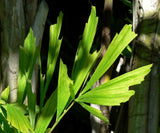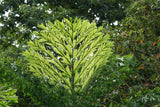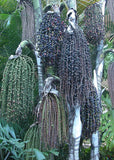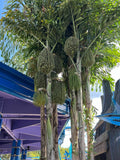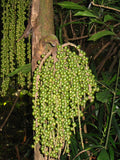Clustering Fishtail Palm Seeds — Caryota mitis: Jungle Drama, Tropical Grace
Planting these seeds is like growing a piece of Southeast Asian rainforest in your own yard: bipinnate fronds that cascade like fish tails, clustered trunks that whisper stories of humid understories, and a legacy of both utility and beauty. These are Caryota mitis seeds — the promise of a luxuriant, tropical sculpture that bridges wildness and domestic elegance.
🌺 Bloom Color & Floral Notes
-
The flowers are pale purple to mauve / purple-lavender, borne on pendent, branched spikes that emerge from the crown of each stem. Once a stem flowers, it follows a characteristic pattern: first blossoms at the top, then progressively lower inflorescences.
-
The floral display is not especially showy compared to some ornamentals, but striking in its grace and form.
❄️ Hardiness & Growing Conditions
-
USDA Hardiness Zones: Primarily zones 9b through 11 for outdoor planting without protection. In marginally cooler areas (zone 10a or possibly lower) you’ll need protection from cold or grow the palm in containers that can be moved indoors in winter.
-
The palm prefers moist, organically rich soil that drains well. While it enjoys high humidity, it can tolerate part shade to full sun (with some shade in very hot climates). Young plants and new trunks are vulnerable to cold and wind.
🐾 Wildlife & Ecological Interactions
-
Larval host plant: Caryota mitis is a recorded host plant for the White-Tipped Skipper (Erionota acroleuca apicalis) butterflies: their caterpillars feed on its leaves, using folded leaf shelters.
-
Butterfly host also: The Chequered Lancer (Plastingia naga) butterfly uses C. mitis as a larval host plant.
-
Frugivory & seed dispersal: Studies (for example in Singapore and on oceanic islands) find that Caryota mitis fruits are eaten by many bird and mammal species, which help disperse seeds. The infructescences (fruit clusters) are abundant, and the palm provides food resource continuity in disturbed habitats and forest edges.
-
Pollinators: The flowers attract pollinating insects; though the palm is not regarded as fragrant in many sources, its blooms are functional and serve as resources for local insect fauna.
🌍 Cultural Significance & Human Uses
-
Native to tropical Asia—from India through Southeast Asia, southern China, Indonesia, Philippines, etc.—Caryota mitis thrives in humid forests. It has naturalized in parts of southern Florida and other tropical/subtropical regions.
-
People have used it traditionally:
• The fibers from petioles (leaf stalks) and sheaths are used for thatch, rope, brushes, coarse thread, tinder (for starting fire).
• On occasion, immature seeds are eaten in some regions (with caution) though mature fruits are toxic. -
In some cultures, it is part of decorative or ceremonial structures; in Vietnam and other regions its foliage and trunks have had symbolic or practical roles in weddings, gates, or forest edge plantings.
⚠ Toxicity & Lifecycle Notes
-
The fruits are toxic: they contain calcium oxalate crystals (raphides). Handling the skin of the fruits (or ingesting) can cause irritation or worse. Use gloves when dealing with fruit, seeds, or damaged pulp.
-
Caryota mitis is monocarpic per stem: each individual stem flowers once, then eventually dies. But because the plant forms a clump with multiple stems (suckers emerging at the base), the clump survives and continues to renew itself.
🌱 Germination & Seed Growing Tips
-
Seeds tend to germinate over several months (often slow start). Fresh seeds germinate more reliably. Warm, moist soil with good organic content helps. Partial shade and shelter help young seedlings avoid stress.
-
Give plenty of space: mature outdoors they can reach 15-25 feet (≈ 4.5-7.5 m) in height and 8-12 feet (≈ 2.5-3.5 m) width in ideal settings. In containers or indoors they are smaller.
✨ Why These Seeds Are Special
Every Caryota mitis seed is a spark of jungle architecture: the dramatic fishtail foliage, the multiple stems, the towering but graceful structure. These are seeds that offer:
-
an opportunity to invite butterflies into your life (White-Tipped Skipper, Chequered Lancer)
-
fruit and seeds that feed wildlife (birds & mammals) in wild or garden edge habitats
-
bold tropical statements for landscaping, or dramatic houseplants indoors
Cultivate them with respect—for their toxic parts, their slow flowering lifecycle, and their power to evoke lush, humid mystery. Grow one and you’re growing more than a plant: you’re growing connection—to ecology, culture, and verdant wildness.






